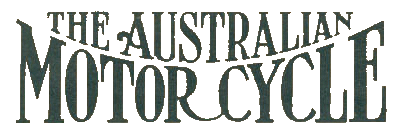


Acknowledgements:
Story and letter courtesy Dave Basham
Quality photographs courtesy Ben Ludolphy
The SR60 was one man's dream of building an all Australian machine to beat the ESO's and JAP's that dominated the sport; these pages look at that dream.
This page looks at the machine itself, and includes:
The Early Days. How the Idea started.
Notes - By Len Dyson. Recalling the First Steps.
The badge is a rich red oval and the lettering stands out proudly, matching the thick golden enamel of the border.
SR60 is an Australian designed and
built speedway bike, SR stands for Southern Racing and 60 indicates the
power output of the engine. Adelaide man Fred Jolly - engineer, dealer, sponsor, garage owner and designer/builder
of the first wholly Australian machine.
Fred believed that his association with speedway that spanned some 40 years, plus five years of design and development that had cost him $35,000 - had resulted in the best speedway bike in the world - of that he had no doubts.
The ESO machine had started to prove
a better prospect than the long standing JAP powered machines, and it was
around the ESO that the SR60 was based, but updated and incorporating several
modifications to engine and frame to increase power and avoid breakages.
The major change in the SR60 design was the use of a single-overhead cam, both the ESO and JAP's being pushrod engines. The OHC layout gave an immediate
increase in useable engine revolutions because the valves are better controlled - and broadly speaking, more revs means more power.
Apart from the system of valve operation the SR60 head is similar to that of the ESO. Valves are English made copies - both in shape and metal (austenitic steel) - of the ESO parts and the ports were exactly the same shape as is the combustion chamber.. The SR60 also shares bore and stroke measurements with the ESO - 88mm bore and 82mm stroke - but the connecting rod of the SR60 is shorter. Fred claimed that this was an aid to low-speed acceleration. It also made the engine one inch lower (19") than the ESO.
The whole engine was cast in a new alloy - A356 - developed by Comalco with a $3 million Commonwealth Government grant. Though of the same weight as other aircraft quality alloys, A356 is considerably stronger. The barrel was nickel iron. A 35mm Dell Orto carburettor was fitted along with a special float-bowl designed and developed by Fred Jolly.
After two years of experimentation, Fred settled on the Lucas rotating-magnet SR1 magneto. The same type was used on such racers as the Manx Norton, but was out of production. Lucas had agreed to make them for the SR60. Oiling was taken care of by a British Pilgrim Pump, the same as was used on JAP machines and similar to that used on the ESO. Net result of the engine variations was that the SR60 developed 60 bhp at 9,000 rpm compared with the 55 bhp at 8,000 rpm of the ESO unit. It was a similar power differential which allowed the ESO to oust the JAP from the speedway tracks of the world.
But the SR60 was not simply a more powerful version of existing speedway types, it was developed to cut down maintenance and prevent the troubles which afflict engines subjected to speedway treatment. The Cam drive (by gears in a tunnel up the side of the motor) can be removed complete with the magneto and without disturbing the timing, simply be removing 4 Allen-bolts. Similarly, the magneto may be swapped in only a couple of minutes.
The frame is almost exactly the same as that of the ESO. The geometry of steering head and fork angles is exactly the same, but a strong cold-drawn steel gusset is fitted at the head-stem and two more gussets support the weld between the main frame and the lower tubes running to the back wheel.
The workmanship on the prototype was impeccable. Every item - even down to the clips to hold the fuel line in place - was expertly made and finished. The
engine castings, by Ellery's Foundry of Adelaide was magnificent. The heads being almost blemish free and an unmachined head-blank needed only internal
polishing. The fibreglass work on mudguards and fuel tank was of a similar high standard - with metal flake coloring cast in so it could not wear off.
Steve Magro in Australia recently contacted me with two very recent photographs of the Fred Jolly SR60 (July 2002), which by the way he still has for sale.
Further reading:
https://www.oldbikemag.com.au/sr60-australia-speedway-dream/
https://forum.ozvmx.com/index.php?topic=21776.0
From the Speedway Workshop Archive